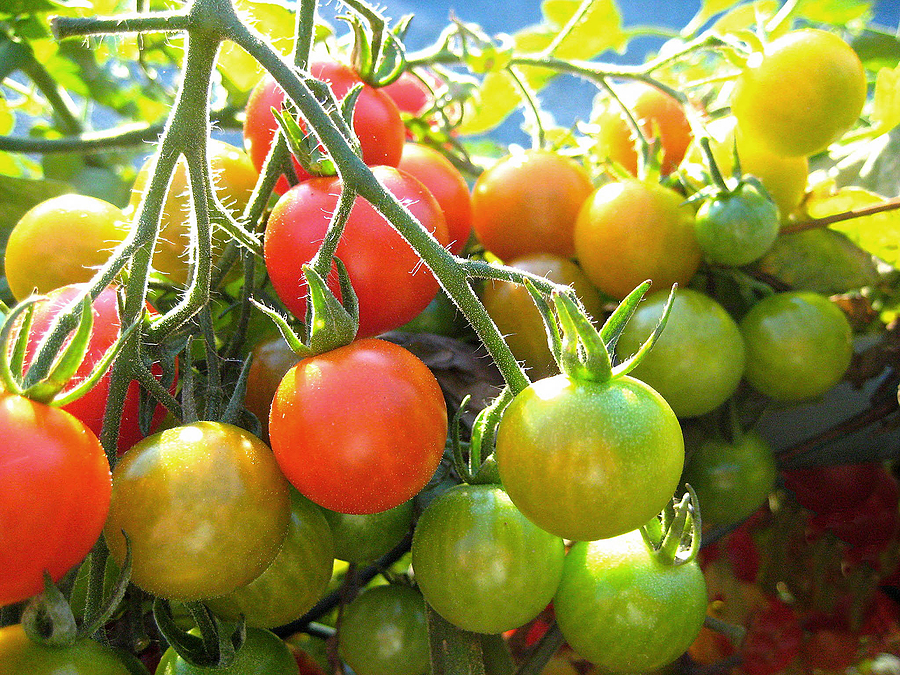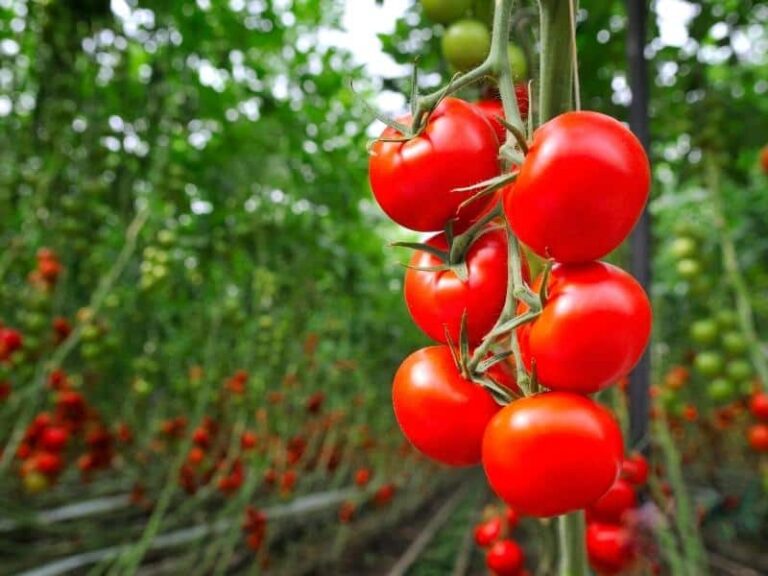As I step into my greenhouse on a chilly winter morning, I’m greeted by a burst of vibrant reds, yellows, and greens. Surrounded by lush foliage and the unmistakable aroma of fresh tomatoes, I’m reminded of the incredible journey that led me to discover the magic of year-round tomato cultivation.
So, if you think can you grow tomatoes year-round in a greenhouse?
The answer is Yes. Today, I’m excited to share my experience and insights with you on the tantalizing possibility of growing tomatoes year-round in a greenhouse.
Here are the tricks:
“To grow healthy tomatoes, start by picking the right tray, preparing the soil, and sowing the seeds. Make sure they get enough light, and as they grow, use compost and fertilizer. Trim indeterminate types and help with pollination for a successful harvest.”
Escape bland store-bought tomatoes and embrace year-round tomato bliss in your own greenhouse garden. Let’s dive into the topic.
Growing Tomatoes in a Greenhouse: A Step-by-Step Guide

Soil: Tomatoes need nutrients to grow well, and compost is great for that. But in a greenhouse with some rain, don’t use too much compost, as it can harm the roots.
In addition, to keep things balanced, use compost moderately, and mix it well with the existing soil. This helps spread the nutrients and improves the soil for the roots.
When planting, dig a hole and use a fertilizer with lots of phosphorous. Tomatoes also like magnesium, nitrogen, calcium, and potassium. But it’s smart to test your soil first to make sure it’s a good fit for tomatoes.
Selecting the Right Tray: To kickstart the process of planting tomato seeds, you have the option of using a standard seeding tray or a soilless tray coupled with a seed nutrient solution. I recommend the RSI Hydroponic Floating Seeding Trays for their proven track record in ensuring robust seedlings for later transplantation.
Preparing the Seeding Tray: Begin by filling your chosen tray with a seedling soil mix and gently moistening it with water. Utilize plain, filtered water and ensure the mixture reaches the optimal moisture level – it should be just wet enough that when squeezed, only a few drops are released.
Sowing the Seeds: Carefully create small, shallow holes within each cell of the tray and place a single tomato seed in each hole. Cover the seeds thoughtfully with your potting mix. It’s advisable to sow approximately 10-15% more seeds than the intended number of plants to allow for the selection of the healthiest seedlings.
Facilitating Germination: Tomato seeds typically sprout within 1-2 weeks under ideal conditions. If your greenhouse’s ambient temperature falls below 65°F, contemplate positioning a heating mat beneath the tray to expedite germination.
Providing Adequate Light: Once your tomato seedlings emerge, ensure they receive an ample amount of light. Grow lights are a reliable option, granting your seedlings the essential light they need to flourish, even during the winter months. It should be used up to 16-18 hours per day.
Transplanting into Individual Pots: When your seedlings boast 1-2 sets of true leaves, it’s time to transplant them into individual pots. These young plants will be ready for transplantation into the ground or raised beds when they reach a height of at least 6 inches.
Container Size Considerations: Keep in mind that indeterminate tomato varieties may produce fewer fruits when grown in containers. Therefore, select an appropriately sized container for each plant.
Alternatively, you can opt to plant your tomatoes along the greenhouse border, offering them more space to grow and greater access to sunlight.
Fertilizing Regularly: These plants are known as heavy feeders, so be diligent about applying nitrogen- and potassium-rich fertilizer every few weeks throughout the growing season to ensure their optimal nourishment and development.
Pruning for Indeterminate Varieties: If you’re cultivating indeterminate tomato plants, regular pruning is essential. Remove suckers and gently guide the plant along its stake, trellis, or cage to provide necessary support for robust growth.
Encouraging Pollination: As your plants begin to flower, you may need to take steps to facilitate pollination. This can be achieved by shaking the plants gently to mimic the wind’s action, opening doors and windows to invite natural pollinators, or employing a mechanical pollinator to ensure proper fruit setting.
How to decide on the type of greenhouse tomato plant to grow?
Indeterminate Tomatoes (Cordon):
Keep growing unless pruned or stopped by frost.
Produce fruit continuously on central vines.
Need support like stakes or cages.
Popular for their prolonged harvest.
Determinate Tomatoes (Bush):
Grow into compact bushes.
Fruit tends to ripen all at once.
Good for processing.
Smaller greenhouses are suitable.
Semi-determinate Tomatoes:
Blend characteristics of both types.
Tend to grow indeterminately but more compact.
Some may fruit like determinate plants.
Generally needs minimal pruning and benefits from staking.
What are the best tomato varieties specifically suited for greenhouse cultivation?
To simplify management, I suggest starting with just 2-3 varieties.
When choosing, opt for seeds labeled as ‘greenhouse varieties’ since they thrive in greenhouse conditions. Look for seeds marked VFNT, indicating resistance to common tomato diseases like verticillium wilt, fusarium wilt, nematodes, and tobacco mosaic virus. Some sellers may require you to select specific disease resistance.
While you may already have some tomatoes in mind, here are our top picks for greenhouse cultivation:
Cherry Tomatoes:
- Small and sweet, perfect for greenhouses.
- Quick to produce fruit, often in under two months.
- Ideal for salads and pasta.
- Consider varieties like Sungold and Black Cherry. Typically indeterminate.
Plum Tomatoes:
- Fleshy with fewer seeds, great for salads or processing into sauces.
- Larger than cherry tomatoes, with an oblong shape.
- Popular varieties include San Marzanos, Regal Plum, and Amish Paste.
- Varieties can be either determinate or indeterminate.
Beefsteak Tomatoes:
- Among the largest and heaviest tomatoes.
- Ideal for grilling, slicing, or using in sandwiches.
- The flavor shines when ripened on the vine, but they can be picked earlier for storage or transportation.
- Consider varieties like Pink Wonder and Purple Cherokee. Typically indeterminate.
What are some common challenges and diseases that tomato plants in a greenhouse?
Aphids: These tiny, soft-bodied insects tend to cluster on tomato plant stems and leaves. To address them, consider pruning affected leaves and manually removing aphids by shaking the plant vigorously or applying organic insecticidal soap.
Tomato Hornworms: These large, vibrant green caterpillars, originating from the five-spotted hawk moth, are voracious eaters that can wreak havoc on your tomato plants. Regularly inspect your plants and promptly remove any hornworms you find by placing them in a soapy water solution.
Damping Off: This disease primarily affects delicate seedlings and is caused by various plant viruses. Infected seedlings suddenly wilt and rot at the soil line. Prevent damping off by using fresh potting soil, maintaining clean trays and tools, and avoiding overwatering your young plants.
Blossom End Rot: This issue manifests as dark, wet spots on the bottom of your tomatoes, rendering them inedible. Instead of being caused by a specific virus, it often results from insufficient calcium in the soil, drought stress, temperature fluctuations, or root damage. To prevent blossom end rot, ensure consistent watering and maintain stable daytime and nighttime temperatures in your greenhouse.
Fusarium Wilt: This disease stems from a soil-borne fungus affecting tomatoes, as well as potatoes, peppers, and eggplants. Early signs include yellowing leaves or brown, smeared tissue on the stalk. Prevent Fusarium wilt by avoiding excessively damp conditions, maintaining appropriate greenhouse temperatures, and refraining from overwatering.
Septoria Leaf Spot: Septoria leaf spot, caused by the fungus Septoria lycopersici, is another common ailment for tomato plants. It presents as brown spots on the foliage, typically starting on older leaves and progressing to newer ones. Early detection allows you to curb its spread by pruning affected leaves.
What are some basic practices to maintain the health of greenhouse tomato plants?

Implement Adequate Ventilation: Properly ventilate your greenhouse to discourage the presence of pests and the onset of diseases.
Soil Management: Either replace old soil or practice crop rotation before planting a new batch of tomatoes. This helps prevent the buildup of pests and root diseases.
Monitor Soil Moisture: Maintain soil moisture levels, but exercise caution to avoid over-watering. Excessively damp soil can facilitate the spread of diseases and mold.
Choose Irrigation Carefully: Avoid installing an overhead irrigation system, as wet leaves on tomato plants are susceptible to diseases. Opt for more targeted irrigation methods.
Regular Pruning: Trim dead or dying leaves to increase sunlight exposure and improve airflow around the plants, promoting overall plant health.
FAQ:
1. Do tomatoes grow better in a greenhouse?
Yes, Tomatoes often grow better in greenhouses due to controlled conditions, protection from pests, and extended growing seasons.
2. Do tomatoes get too hot in a greenhouse?
Yes, Tomatoes can get too hot in a greenhouse if proper ventilation and temperature control measures are not in place. Adequate ventilation and shading can prevent overheating.
3. How many tomatoes can you grow in a greenhouse?
The number of tomatoes you can grow in a greenhouse depends on its size and layout, but a well-organized greenhouse can yield a significant number of tomato plants.
4. Why are my tomatoes dying in my greenhouse?
Tomatoes in a greenhouse can die due to various factors, including disease, overwatering, nutrient deficiencies, or inadequate pest control. Proper care and monitoring are essential to address these issues.
5. What is the best soil for greenhouse tomatoes?
The best soil for greenhouse tomatoes is well-draining and nutrient-rich, typically a mix of compost, peat moss, and perlite or vermiculite to provide good aeration and water retention.
6. How do you increase the yield of tomatoes in a greenhouse?
To increase tomato yield in a greenhouse, focus on proper pruning, trellising, balanced fertilization, maintaining consistent temperatures, and ensuring adequate pollination.
7. What is the best fertilizer for tomatoes in a greenhouse?
A balanced, slow-release fertilizer with essential nutrients like nitrogen, phosphorus, and potassium is ideal for greenhouse tomatoes. Additionally, supplement with micronutrients as needed for optimal growth and fruiting
Conclusion
To sum up, growing tomatoes year-round in my greenhouse has been a rewarding endeavor. It all starts with careful soil management, where I’ve learned that using compost in moderation and testing my soil’s suitability for tomatoes is essential.
Also, choosing the right trays, ensuring optimal moisture levels during seeding, and providing adequate light have been crucial steps in nurturing healthy tomato plants. Transplanting them into individual pots or along the greenhouse border has given me flexibility in their growth.
Moreover, I’ve come to appreciate that these plants are heavy feeders, and regular fertilization, as well as the diligent pruning of indeterminate varieties, ensures their optimal nourishment and development. Further, facilitating pollination, whether by shaking the plants gently or inviting natural pollinators, has also been a part of the journey.
While there are challenges, the controlled greenhouse environment has made year-round tomato cultivation a reality for me. With dedication and proper greenhouse management, I’ve been able to enjoy homegrown tomatoes in every season.

